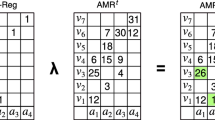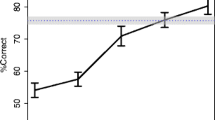Abstract
This paper briefly summarizes much of the work in pattern recognition to date, and relates the rubber mask technique to previous work. A scheme for incorporating flexible-mask methods into a proposed pattern recognition and memory system is presented. A discussion based on some facts and on some conjecture of the human eye/brain system and how it recognizes patterns, possibly by flexible matching, is also presented.
Access this chapter
Tax calculation will be finalised at checkout
Purchases are for personal use only
Preview
Unable to display preview. Download preview PDF.
Similar content being viewed by others
References
B. Widrow, “The rubber mask” technique I: Pattern measurement and analysis,” Pattern Recognition 5, 175–197 (1973).
C.J.W. Mason, “Pattern Recognition Bibliography”, IEEE Systems, Man, and Cybernetics, Group Newsletter, October 1970, December 1970, February 1971, June 1971.
R.L. Gregory, “Eye and Brain: The Psychology of Seeing”, World University Library. McGraw-Hill, New York (1966).
Police identification kits are manufactured by the Identi-Kit Company which claims for its product in an advertisement on page 39 of Law and Order, September 1972:…It allows you to go to the witness or victim of a crime and develop a composite facial likeness of a suspect within minutes. Manual overlay of six to nine facial components becomes a complete line drawing without the use of complicated machines, photographs or the services of an artist. Also, Identi-Kit composites are easily reproduced and automatically code themselves for instant transmission to other Identi-Kit users all over the world….
B. Julesz, Foundations of Cyclopean Perception. University of Chicago Press, Chicago (1971).
Plato’s Republic, Book VI, Jowett Translation, Random House, Vintage Paperbacks.
Adaline/Madaline
B. Widrow and M.E. HOFF, “Adaptive switching circuits”, WESCON Convention Ree., Institute of Radio Engineers, N.Y. Pt. 4, pp. 96–104 (1960).
B. Widrow, “Generalization and information storage in networks of Adaline ‘neurons’,” Self Organizing Systems, M.C. Yovitz, G.T. Jacobi and G.D. Goldstein (eds) pp. 435–461. Spartan, Washington, D.C. 1962.
K. Steinbuch and B. Widrow, “A critical comparison of two kinds of adaptive classification networks”, IEEE Trans. Electronic Computers EC-14 (5), 737–740 (1965)
J.S. Koford and G.F. Groner, “The use of an adaptive threshold element to design a linear optimal pattern classifier,”IEEE Trans. Information Theory IT-12, 42–50 (1966)
C.H. Mays, “Effects of adaptation parameters on convergence time and tolerance for adaptive threshold elements”, IEEE Trans. Electronic Computers (short notes) EC-13, 465–468 (1964).
N.J. Nilsson, Learning Machines. McGraw-Hill, New York (1965).
B. Widrow et al., “Adaptive antenna systems,” Proc. IEEE 55, 2143–2159 (1967).
Perceptron
F. Rosenblatt, “The perceptron, a theory of statistical separability in cognitive systems”, Report VG-1196-G-1, Cornell Aeronautical Lab., Buffalo, New York (1958).
F. Rosenblatt, Principles of Neurodynamics, and the Theory of Brain Mechanisms. Spartan Books, Washington, P.C. (1962).
H.P. Block, “The perceptron: A model for brain functioning”. I, Rev. Mod. Phys. 34 (1), 123–135 (1962).
H.P. Block, B.W. Knight and F. Rosenblatt, “Analysis of a four- layer series-coupled perceptron.” II, Rev. Mod. Phys. 34 (1), 135–142 (1962).
N.J. Nilsson, Learning Machines. McGraw-Hill, New York (1965).
G. Nagy, “The state of art in pattern recognition”, Proc. IEEE 56 (5), 836–862 (1968).
M.L. Minsky and S. Papert, Perceptrons: an Introduction to Computational Geometry. M.I.T. Press, Cambridge, Mass. (1969).
Matched Filters and Learning Matrices
“Matched filter issue”, IRE Trans. Information Theory IT-6, 309–417 (1960).
T. KaiLath, “Adaptive matched filters”, Mathematical Optimization Techniques, R. Bellman (ed), pp. 109–140. University of California Press (1963).
K. Steinbuch and U.A.W. Piske, “Learning matrices and their applications”, IEEE Trans. Electronic Computers EC-12 (5), 846–862 (1963).
H. Kazmierczak and K. Steinbuch, “Adaptive systems in pattern recognition,” IEEE Trans. Electronic Computers EC-12 (5), 822–835 (1963).
Linear and Polynomial Discriminants
W.H. Highleyman, “Linear decision functions, with application to pattern recognition”, Proc. IRE 50, 1501–1514 (1962).
T.W. Anderson, Introduction to Multivariate Statistical Analysis. Wiley, New York (1965).
J.S. Koford and G.F. Groner,”The use of an adaptive threshold element to design a linear optimal pattern classifier”, IEEE Trans. Information Theory IT-12, 42–50 (1966).
D. F. Specht, “Generation of polynomial discriminant-functions for pattern recognition”, IEEE Trans. Electronic Computers EC-16 (1), 308–319 (1967).
D.F. Specht, “Vectorcardiographic diagnosis using the polynomial discriminant method of pattern recognition”, IEEE Trans. Biomedical Electronics BME-14 (2), 90–95 (1967)
Nearest Neighbour Rules
T.M. Cover and P. E. Hart, “Nearest neighbor pattern classification”, IEEE Trans. Information Theory IT-13 (1), 21–27 (1967).
T.M. Cover, “Estimation by the nearest neighbor rule”, IEEE Trans. Information Theory IT-14 (1), 50–55 (1968).
Integral Geomatry
L.A. Santalo, Introduction to Integral Geometry. Hermann, Paris (1953).
A.B.J. Novikoff, “Integral geometry as a tool in pattern perception”, Principles of Self-Organization, Von FORESTER and Zopf (eds), pp. 347–368, Pergamon, Oxford (1962).
G. Tenery, “Pattern recognition function of integral geometry”, IEEE Trans. Military Electronics MIL-7, 196–199 (1963).
E. Wong and J.A. Steppe, “Invariant recognition of geometrical shapes”, Methodologies of Pattern Recognition, S. Watanabe (ed), pp. 535–543. Academic, New York (1969).
Pattern Classification by Clustering/Learning without a teacher
F. Mosteller, “On pooling data”, J. Am. Stat. Assoc. 43 (242), 231–242 (1948).
T.T. Tanimoto and D.J. Rogers, “A computer program for classifying plants”, Science 132 (3434), 1115–1118 (1960).
D.B. Cooper and P.W. Cooper, “Nonsupervised adaptive signal detection and pattern recognition”, Inform. Control 7 (3), 416–444 (1964).
R.E. Bonner, “On some clustering techniques”, IBM J. Res. Dev. 8 (1), 22–32 (1964).
R.L. Mattson and J.E. Dammann, “A technique for determining and coding subclasses in pattern recognition problems”, IBM J. Res. Dev. 9 (4), 294–302 (1965).
G.H. Ball and D.J. Hall, “Isodata, a novel method of data analysis and pattern classification”, Stanford Research Institute, Menlo Park, Calif. (April 1965).
J. Spragins, “Learning without a teacher”, IEEE Trans. Information Theory IT-12 (2), 223–230 (1966).
S.C. Fralick, “Learning to recognize patterns without a teacher”, IEEE Trans. Information Theory IT-13 (1), 57–64 (1967).
W.C. Miller, “A modified mean square error criterion for use in unsupervised learning”, Stanford Electronics Laboratories, Stanford, Calif., Tech. Rept. SEL-67–066 (TR 6778–2) (August 1967).
YA.Z. Tsypkin, “Self learning—what is it?” IEEE Trans. Automatic Control AC13 (6), 608–612 (1968).
C.G. Hilborn, Jr. and D.G. Lainiotis, “Unsupervised learning minimum risk pattern classification for dependent hypotheses and dependent measurements”, IEEE Trans. Systems Science and Cybernetics SSC-5 (2), 109–115 (1969).
A.N. Mucciardi and E.E. Gose, “An automatic algorithm and its properties in high-dimensional spaces,” IEEE Trans. Systems, Man and Cybernetics SMC-2 (2), 247–254 (1972).
Linguistic Approach to Pattern Recognition
R.A. Kirsch, “Computer interpretation of English text and picture patterns”, IEEE Trans. Electronic Computers EC-13, 363–376 (1964).
R.S. Ledley, “High-speed automatic analysis of biomedical pictures”, Science 146, 216–223 (1964).
N. Chomsky, Aspects of the Theory of Syntax. M.I.T. Press (1965).
R. Narasimhan, “Syntax-directed interpretation of classes of pictures”, Comm. ACM 9, 166–173 (1966).
M.B. Clowes, “Transformational grammars and the organization of pictures”, Automatic Interpretation and Classification of Images, A. Grasselli (ed), pp. 43–76. Academic, New York (1969).
R. Narasimhan, “On the description, generation, and recognition of classes of pictures”, Automatic Interpretation and Classification of Images, A. Grasselli (ed), pp. 1–41. Academic, New York (1969).
M. Eden, “Handwriting generation and recognition”, Recognizing Patterns, P.A. Kolers and M. Eden (eds) pp. 138–154. M.I.T. Press, Cambridge, Mass. (1968).
W.F. Miller and A.C. Shaw,”Linguistic methods in picture processing—a survey”, Fall Joint-Computer Conference, pp. 279–290 (December 1968).
A. Rosenfeld, “Chapter on picture description and picture languages,” Picture Processing by Computer, pp. 167–184. Academic, New York (1969).
J. Hopcroft and J. Ullman, Formal Languages and their Relation to Automata. Addison-Wesley, Reading, Mass. (1969).
A.C. Shaw, “Parsing of graph-representable pictures”; J. ACM 17 (3), 453–481 (1970).
H.C. Lee and K.S. FU, “A stochastic syntax analysis procedure and its application to pattern recognition,” IEEE Trans. Comp., (July 1972).
“Special Issue on Syntactic Pattern Recognition”, Pattern Recognition 4, No. 1 (January 1972).
Fingerprint Recognition
William DIENSTEIN, Technics for the Crime Investigator. Charles C. Thomas (1952).
A. Grasselli, “On the automatic classification of fingerprints”, Methodologies of Pattern Recognition, S. Watanabe (ed.), pp. 253–315. Academic, New York (1969).
L.S. Penrose, “Dermatoglyphics”, Scient, Am. pp. 72–84 (December 1969).
“Proc. 1st and 2nd Natl. Symp. Law Enforcement Science and Technology” Thompson/Academic Press and IITRI. Articles
John E. GAFFNEY, JR. et al., “Fingerprint encoding and matching procedures for automated recognition systems”
C.B. Shelman, “Machine extraction of ridge endings from a noisy fingerprint”, pp. 409–416.
Vincent V. Horvath and Charles D. Doyle, “Recent developments in fingerprint recognition using coherent optical processing”, pp. 417–426.
Bernard M. Van Emden, “Advanced computer based fingerprint automatic classification technique” (FACT), pp. 493–505.
M.D. Freedman and E.D. Hietanen, “Application of parallel neighborhood logic to fingerprint processing”, pp. 507–509.
Richard W. Schwartz, “System considerations in automated fingerprint classification”, pp. 511–515.
Human Vision
R.L. Gregory, Eye and Brain, the Psychology of Seeing. World University Library, McGraw-Hill, New York (1966).
E.R. Hilgard and G.H. Bower, Theoriesof Learning, 3rd ed. Appleton-Century-Crofts, New York (1966).
P.C. Dodwell, Visual Pattern Recognition. Holt, Rinehart and Winston, New York (1970).
T.N. Cornsweet, “Measuring movements of the retinal image with respect to the retina”, Biomedical Sciences Instrumentation, W.E. Murray and P.F. Salisbury (ed), vol. 2. Plenum, New York (1964).
N.H. Mackworth, “A stand camera for line-of-night recording”, Perception and Psychophysics 2 (1967).
N.H. Mackworth and J.S. Bruner, “How adults and children search and recognize pictures”, Human Development 13, 149–177 (1970).
Books on Pattern Recognition
G.L. Fischer, Jr., D.K. Pollock, B. Radack and M.E. Stevens (eds), Optical Character Recognition. Spartan Books, Washington (1962).
G. Sebestyen, Decision-Making Process in Pattern Recognition. Macmillan, New York (1962).
D.K. Pollock, C.J. Koester and J.T. Tippett, Optical Processing of Information. Spartan Books, Washington, D.C. (1963).
N.J. Nilsson, Learning Machines. McGraw-Hill, New York (1965).
L. Uhr, Pattern Recognition. Wiley, New York (1966).
K.S. Fu, Sequential Methods in Pattern Recognition and Machine Learning. Academic, New York (1968).
L.N. Kanal (ed), Pattern Recognition. Thompson, Washington (1968).
A. Rosenfeld, Picture Processing by Computer. Academic, New York (1969).
M.S. Watanabe, Methodologies of Pattern Recognition. Academic, New York (1969).
A. Grasselli (ed), Automatic Interpretation and Classification of Images. Academic, New York (1969).
J. Mendel and K. S. Fu, Adaptive Learnings and Pattern Recognition: Theory and Applications. Academic, New York (1970).
N. Bongard, Pattern Recognition. Spartan Books, New York (1970).
YA. Z. Tsypkin, Adaptation and Learning in Automatic Systems. Academic, New York (1971).
K.S. Fu (ed) Pattern Recognition and Machine Learning. Plenum, New York (1971).
O. Grusser and R. Klinke (eds), Pattern Recognition in Biological and Technical Systems. Springer, Berlin, New York(1971).
K. Fukunaga, Introduction to Statistical Pattern Recognition. Academic, New York (1972).
Optical Character Recognition(OCR)
G.L. Fischer, Jr., D.K. Pollock, B. Radack and M.E. Stevens (eds), Optical Character Recognition. Spartan Books, Washington, D.C. (1962).
C.N. Liu and G.L. Shelton, JR., “An experimental investigation of a mixed-font print recognition system” IEEE Trans. Computers EC-15 (6), 916–925 (1966).
G. Nagy, “Preliminary investigation of techniques for automated reading of unformatted text,” IBM Res. RC 1867, York-town Heights, New York (30 June 1967)
T. Trickett, “The design of a standard type font for optical character recognition,” Honeywell Comput. Jl. 3 (1), 2–11 (1969).
“Special issue on Optical Character Recognition”, Pattern Recognition 2, No. 3 (September 1970).
J.R. Parks, “A multi-level system of analysis for mixed font and hand-blocked printed character recognition” Automatic Interpretation and Classification of Images, A. Grasselli (ed), pp. 295–322. Academic, New York (1969).
Author information
Authors and Affiliations
Editor information
Editors and Affiliations
Rights and permissions
Copyright information
© 1974 Plenum Press, New York
About this chapter
Cite this chapter
Widrow, B. (1974). The “Rubber-Mask” Technique-II, Pattern Storage and Recognition. In: Fu, K.S., Tou, J.T. (eds) Learning Systems and Intelligent Robots. Springer, Boston, MA. https://doi.org/10.1007/978-1-4684-2106-4_20
Download citation
DOI: https://doi.org/10.1007/978-1-4684-2106-4_20
Publisher Name: Springer, Boston, MA
Print ISBN: 978-1-4684-2108-8
Online ISBN: 978-1-4684-2106-4
eBook Packages: Springer Book Archive




